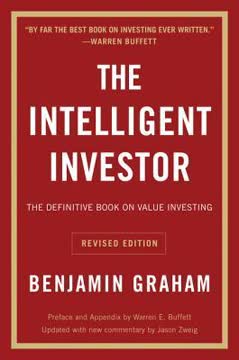Key Takeaways
1. Understand the fundamentals of value investing
"Value investors view the stock market differently than other investors. They don't believe that the stock market consists of stocks. They know that the stock market consists of real companies."
Foundation of value investing. Value investing is based on the principle that stocks represent ownership in real businesses, not just ticker symbols. This perspective shifts the focus from short-term price fluctuations to long-term business performance and intrinsic value.
Mr. Market analogy. Benjamin Graham's concept of Mr. Market illustrates the emotional nature of the stock market. Mr. Market offers to buy or sell stocks at different prices each day, sometimes irrationally. Value investors take advantage of these price fluctuations to buy undervalued stocks and sell overvalued ones.
Long-term approach. Value investing emphasizes patience and a long-term perspective. Instead of trying to time the market or make quick profits, value investors focus on:
- Identifying high-quality businesses
- Buying stocks at a discount to their intrinsic value
- Holding investments for extended periods to allow compounding and value realization
2. Learn to view the stock market differently
"Good news! The market is dropping."
Opportunity in market declines. For value investors, market downturns represent buying opportunities rather than reasons for panic. When stock prices fall, high-quality companies become available at discounted prices, allowing investors to potentially earn higher long-term returns.
Price vs. value distinction. Value investors understand that a stock's price and its intrinsic value are often different. This discrepancy creates opportunities for profit. Key points to remember:
- Stock prices fluctuate based on short-term emotions and market sentiment
- Intrinsic value is based on a company's long-term earnings potential and fundamentals
- Success in investing comes from identifying and exploiting these discrepancies
Contrarian thinking. Value investing often requires going against the crowd and popular opinion. This contrarian approach allows investors to:
- Buy when others are fearful and selling
- Sell when others are greedy and buying
- Avoid market bubbles and irrational exuberance
3. Grasp key economic concepts: interest rates, inflation, and bonds
"Interest rates work like gravity."
Interest rates' impact. Interest rates play a crucial role in the economy and stock market valuations. They affect:
- Borrowing costs for businesses and consumers
- Relative attractiveness of stocks compared to bonds
- Overall economic growth and inflation rates
Inflation considerations. Investors must account for inflation when evaluating returns and making investment decisions. Key points:
- Inflation erodes purchasing power over time
- Real returns (adjusted for inflation) matter more than nominal returns
- Companies with pricing power can better withstand inflationary pressures
Bond basics. Understanding bonds is essential for a well-rounded investment approach:
- Bonds represent loans to companies or governments
- Bond prices move inversely to interest rates
- Bonds can provide income and portfolio diversification
- The risk-free rate (usually government bonds) serves as a benchmark for evaluating other investments
4. Master Warren Buffett's four investing principles
"Vigilant leaders, long-term prospects, stock stability, and attractive prices."
Principle 1: Vigilant leaders. Look for companies with strong management teams that:
- Maintain low debt levels (debt-to-equity ratio below 0.5)
- Demonstrate high current ratios (above 1.5)
- Consistently achieve strong returns on equity (above 8%)
- Have appropriate management incentives aligned with shareholder interests
Principle 2: Long-term prospects. Invest in companies with:
- Persistent products or services that will remain relevant for decades
- Business models that can withstand technological disruption
- Tax-efficient operations that maximize long-term shareholder value
Principle 3: Stock stability. Seek companies that demonstrate:
- Consistent book value growth from owner's earnings
- Sustainable competitive advantages (economic moats)
- Predictable and stable financial performance over time
Principle 4: Attractive prices. Buy stocks at a discount to their intrinsic value by:
- Maintaining a margin of safety between purchase price and estimated value
- Considering key valuation metrics like P/E ratio and P/B ratio
- Using discounted cash flow analysis to estimate intrinsic value
5. Decode financial statements: income statement, balance sheet, and cash flow
"Accounting is the language of business." - Warren Buffett
Income statement analysis. The income statement shows a company's profitability over a specific period. Key components to focus on:
- Revenue: Total sales generated by the company
- Gross profit: Revenue minus cost of goods sold
- Operating income: Profit from core business operations
- Net income: Bottom-line profit after all expenses and taxes
Balance sheet interpretation. The balance sheet provides a snapshot of a company's financial position at a specific point in time. Important elements include:
- Assets: What the company owns (e.g., cash, inventory, property)
- Liabilities: What the company owes (e.g., debt, accounts payable)
- Shareholders' equity: The difference between assets and liabilities
Cash flow statement insights. The cash flow statement shows how cash moves through the business. Three main sections to examine:
- Cash from operating activities: Cash generated from core business operations
- Cash from investing activities: Cash used for long-term investments and asset purchases
- Cash from financing activities: Cash from debt, equity issuance, or dividend payments
6. Analyze company financials using key ratios
"Valuing a business is part art and part science."
Profitability ratios. These ratios measure a company's ability to generate profits relative to revenue, assets, or equity. Key ratios include:
- Return on Equity (ROE): Net income / Shareholders' equity
- Return on Assets (ROA): Net income / Total assets
- Net profit margin: Net income / Revenue
Liquidity ratios. These ratios assess a company's ability to meet short-term obligations. Important liquidity ratios:
- Current ratio: Current assets / Current liabilities
- Quick ratio: (Current assets - Inventory) / Current liabilities
Efficiency ratios. These ratios evaluate how effectively a company uses its assets and manages its operations. Examples include:
- Inventory turnover: Cost of goods sold / Average inventory
- Accounts receivable turnover: Revenue / Average accounts receivable
Solvency ratios. These ratios measure a company's long-term financial stability. Key solvency ratios:
- Debt-to-equity ratio: Total debt / Shareholders' equity
- Interest coverage ratio: Operating income / Interest expense
7. Evaluate intrinsic value and make informed investment decisions
"Intrinsic value can be defined simply: It is the discounted value of the cash that can be taken out of a business during its remaining life."
Intrinsic value calculation. Estimating a company's intrinsic value involves projecting future cash flows and discounting them to present value. Key steps in the process:
- Estimate future free cash flows
- Determine an appropriate discount rate
- Calculate the present value of projected cash flows
- Add a terminal value for cash flows beyond the projection period
- Sum the discounted cash flows to arrive at the intrinsic value
Margin of safety. Always buy stocks with a significant margin of safety – the difference between the intrinsic value and the current market price. This provides a buffer against estimation errors and unforeseen events.
Investment decision framework. When making investment decisions, consider:
- The quality of the business and its competitive advantages
- The company's financial health and historical performance
- The current valuation relative to intrinsic value estimates
- The potential risks and downside scenarios
- Your overall portfolio allocation and diversification strategy
Remember that successful value investing requires patience, discipline, and continuous learning. By mastering these key concepts and applying them consistently, investors can improve their chances of achieving long-term success in the stock market.
Last updated:
FAQ
What's "Warren Buffett Accounting Book" about?
- Purpose: The book aims to teach everyday investors how to understand and apply Warren Buffett's investing principles without needing a master's degree in finance.
- Content: It covers essential accounting terminology and techniques necessary for serious stock investors, focusing on reading financial statements for value investing.
- Structure: The book is divided into two parts: the first half introduces stock market concepts and value investing principles, while the second half delves into detailed accounting and financial statement analysis.
- Authors: Written by Stig Brodersen and Preston Pysh, the book is part of a series that includes summaries of other influential investing books.
Why should I read "Warren Buffett Accounting Book"?
- Practical Guidance: It provides practical guidance on how to think about the stock market and select and value stocks using Warren Buffett's principles.
- Comprehensive Learning: The book offers a comprehensive learning experience, from basic stock market concepts to detailed financial statement analysis.
- Value Investing Focus: It focuses on value investing, a proven strategy used by Warren Buffett to achieve long-term wealth.
- Author Expertise: The authors, Stig Brodersen and Preston Pysh, are experienced investors and educators who simplify complex financial concepts.
What are the key takeaways of "Warren Buffett Accounting Book"?
- Value Investing Principles: The book outlines four key principles of value investing: vigilant leadership, long-term prospects, stability and understandability, and buying at attractive prices.
- Financial Statement Analysis: It emphasizes the importance of understanding financial statements, including the income statement, balance sheet, and cash flow statement.
- Risk Management: The book teaches how to manage risk by focusing on companies with low debt, high return on equity, and stable earnings.
- Intrinsic Value Calculation: It provides methods for calculating the intrinsic value of stocks to identify undervalued investment opportunities.
How does "Warren Buffett Accounting Book" explain financial statements?
- Income Statement: The book breaks down the income statement into revenues, expenses, and net income, explaining each component's significance.
- Balance Sheet: It details the balance sheet's assets, liabilities, and equity, showing how they reflect a company's financial health.
- Cash Flow Statement: The book highlights the cash flow statement's role in connecting the income statement and balance sheet, emphasizing cash flow from operations, investing, and financing activities.
- Practical Examples: Throughout, the book uses practical examples to illustrate how to read and interpret financial statements effectively.
What are the four principles of value investing according to "Warren Buffett Accounting Book"?
- Vigilant Leadership: Companies should have management that acts in the best interest of shareholders, with low debt and high return on equity.
- Long-term Prospects: Invest in companies with products or services that have persistent demand and minimize taxes by holding investments long-term.
- Stability and Understandability: Focus on stable companies with understandable business models and a sustainable competitive advantage.
- Attractive Prices: Buy stocks with a wide margin of safety, low price-earnings and price-to-book ratios, and a safe discount rate.
How does "Warren Buffett Accounting Book" suggest calculating intrinsic value?
- Discount Cash Flow Model: The book introduces a six-step process to estimate free cash flow, apply a discount rate, and calculate the intrinsic value.
- BuffettsBooks Calculator: It offers an alternative method using book value growth and dividends to determine intrinsic value, emphasizing stable companies.
- Discount Rate Importance: The discount rate is crucial for assessing risk and expected returns, with a higher rate indicating higher risk.
- Practical Tools: The book provides online calculators and examples to help readers apply these methods to real-world stocks.
What is the significance of the cash flow statement in "Warren Buffett Accounting Book"?
- Cash Flow from Operations: It reflects a company's ability to generate cash from its core business activities, crucial for assessing financial health.
- Investing Activities: The book explains how cash flow from investing activities indicates a company's growth strategy and asset management.
- Financing Activities: It highlights the importance of understanding cash flow from financing activities, such as debt issuance and dividend payments.
- Overall Insight: The cash flow statement provides a comprehensive view of a company's cash management, bridging the income statement and balance sheet.
How does "Warren Buffett Accounting Book" address risk management?
- Debt Management: The book emphasizes avoiding companies with high debt-to-equity ratios, as excessive debt increases financial risk.
- Return on Equity: It suggests focusing on companies with a strong and consistent return on equity, indicating efficient use of shareholder funds.
- Current Ratio: A high current ratio is preferred to ensure a company can meet its short-term obligations without financial strain.
- Interest Coverage Ratio: The book advises monitoring this ratio to assess a company's ability to cover interest expenses with operating income.
What are the best quotes from "Warren Buffett Accounting Book" and what do they mean?
- "Mr. Market is your servant, not your guide." This quote emphasizes the importance of viewing market fluctuations as opportunities rather than being swayed by them.
- "In the short run, the market is a voting machine, but in the long run it is a weighing machine." It highlights the difference between short-term market sentiment and long-term intrinsic value.
- "Cash is King." This underscores the importance of cash flow in assessing a company's financial health and investment potential.
- "Valuing a business is part art and part science." It reflects the blend of quantitative analysis and qualitative judgment required in investment decisions.
How does "Warren Buffett Accounting Book" explain the concept of margin of safety?
- Definition: Margin of safety is the difference between a stock's intrinsic value and its market price, providing a buffer against errors in valuation.
- Importance: A wide margin of safety reduces investment risk by allowing for potential inaccuracies in estimating a company's value.
- Application: The book advises seeking stocks with a significant margin of safety to ensure a favorable risk-reward ratio.
- Investment Decisions: It emphasizes that a larger margin of safety is preferable, especially when market conditions are uncertain.
How does "Warren Buffett Accounting Book" suggest using financial ratios?
- Profitability Ratios: The book explains how to use ratios like gross profit margin, operating margin, and net income margin to assess a company's profitability.
- Liquidity Ratios: It highlights the importance of current and acid-test ratios in evaluating a company's ability to meet short-term obligations.
- Efficiency Ratios: The book discusses inventory turnover and accounts receivable turnover ratios to measure operational efficiency.
- Solvency Ratios: It emphasizes the debt-to-equity and liabilities-to-equity ratios for assessing a company's financial stability and risk.
What resources does "Warren Buffett Accounting Book" provide for further learning?
- Online Community: The book directs readers to BuffettsBooks.com, a free educational website with videos and forums for learning value investing.
- Calculators: It offers online calculators for intrinsic value and sell decisions, helping readers apply the book's concepts to real-world stocks.
- Recommended Readings: The book lists additional resources, including influential investing books and Warren Buffett's shareholder letters, for further study.
- Author Expertise: The authors, Stig Brodersen and Preston Pysh, provide ongoing support and insights through their podcast and online community.
Review Summary
Warren Buffett Accounting Book receives mostly positive reviews for its clear explanations of financial statements and value investing principles. Readers appreciate its beginner-friendly approach, real-world examples, and focus on Buffett's investment strategies. Many find it helpful for understanding accounting concepts and financial ratios. Some reviewers note that while it's a good introduction, it may not provide advanced insights for experienced investors. The book is praised for its practical tools and straightforward language, making it accessible to those new to investing and financial analysis.
Similar Books










Download PDF
Download EPUB
.epub digital book format is ideal for reading ebooks on phones, tablets, and e-readers.




